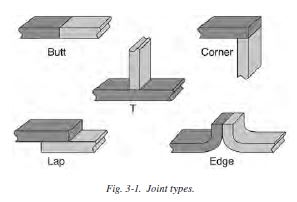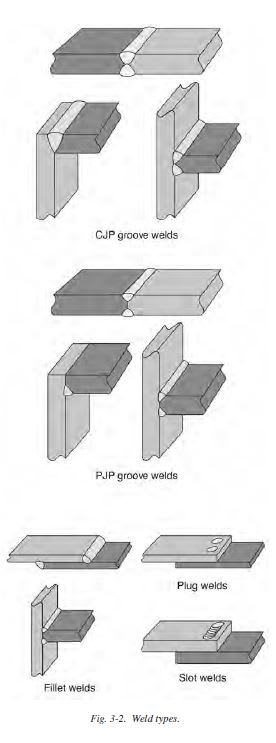Navigation
Install the app
How to install the app on iOS
Follow along with the video below to see how to install our site as a web app on your home screen.
Note: This feature may not be available in some browsers.
More options
Style variation
-
Congratulations cowski on being selected by the Eng-Tips community for having the most helpful posts in the forums last week. Way to Go!
You are using an out of date browser. It may not display this or other websites correctly.
You should upgrade or use an alternative browser.
You should upgrade or use an alternative browser.
Stronger weld Butt or Fillet? 5
- Thread starter purode333
- Start date
- Status
- Not open for further replies.
Define stronger. Stronger in tensile, in fatigue, ?
Geometry of the weld is in most cases not an option.
I'd be tempted to say that a butt weld is stronger, simply because of the lack of crack initiations, however there are many ways to construct a fillet weld that will easily outperform a butt weld.
Anyway, in most cases the weld is (or should be) stronger than the base material, so this is a moot point.
Geometry of the weld is in most cases not an option.
I'd be tempted to say that a butt weld is stronger, simply because of the lack of crack initiations, however there are many ways to construct a fillet weld that will easily outperform a butt weld.
Anyway, in most cases the weld is (or should be) stronger than the base material, so this is a moot point.
Hi
Normally butt welds are stronger than fillet, butt welds usually used on the seams of pressure vessels to resist tensile forces, fillet welds generally fail by shear stress on the throat of the weld.
Like other posters have stated it depends on weld size, configuration and how the component is loaded.
“Do not worry about your problems with mathematics, I assure you mine are far greater.” Albert Einstein
Normally butt welds are stronger than fillet, butt welds usually used on the seams of pressure vessels to resist tensile forces, fillet welds generally fail by shear stress on the throat of the weld.
Like other posters have stated it depends on weld size, configuration and how the component is loaded.
“Do not worry about your problems with mathematics, I assure you mine are far greater.” Albert Einstein
If the weld is capable in developing the strength of the adjoining members in shear, tension, etc., does it really matter if it is a fillet or groove weld?
The question is akin to which is stronger, a length of string or a length of cord? There's a lot of follow up questions before a reasonable response can be expected.
Best regards - Al
The question is akin to which is stronger, a length of string or a length of cord? There's a lot of follow up questions before a reasonable response can be expected.
Best regards - Al
-
5
- #6
This isn't a well worded question for the following reason - A butt joint is a type of joint and a fillet weld is a type of weld.purode333 said:Which will be the strongest weld to be consider, Butt or fillet?
A butt joint can only be welded with a groove weld, that groove weld may be complete joint penetration (CJP) or partial joint penetration (PJP); it cannot be welded with a fillet weld.
To further expound upon this, there are essentially 5 different joint types: butt, corner, T, lap, and edge.

And there are four major weld types: CJP groove weld, PJP groove weld, fillet welds, and plug/slot welds.

The only joint that can truly use either a groove weld or a fillet weld is a T-joint (a corner joint would result in a fillet weld on only one side which is less than ideal). In designing the T-joint both the groove weld and fillet weld could be sized to develop the full strength of the base metal (this would require a CJP groove weld, which by definition will develop the strength of the base metal). However, CJP (and PJP)groove welds perform better in fatigue applications than do fillet welds.
dauwerda said:This isn't a well worded question for the following reason - A butt joint is a type of joint and a fillet weld is a type of weld.
Different regions have different terminology. In AUS a butt weld is a weld.
An interesting question. In my opinion butt welds are normally stronger that fillet welds in the situation that I am describing. The construction company for which I worked bought a second hand barge with spuds. It was winter and the barge that we used to support cranes over water was secured by its spuds. The barge caused ice to build up upstream of it and got loose in the process. We retrieved the barge and eventually part of the spud that laid on the river bed. The segment of the spud that broke off was examined and we noticed that it had been fillet welded to the upper part of the spud that remained with the barge. We proceeded to do a butt weld by carfully grooving the edges during repairs between the two segments of the spud and had no further incident during that very cold winter.
- Status
- Not open for further replies.
Similar threads
- Locked
- Question
- Replies
- 3
- Views
- 1K
- Replies
- 0
- Views
- 491
- Locked
- Replies
- 5
- Views
- 5K
- Replies
- 5
- Views
- 8K
- Replies
- 5
- Views
- 2K
